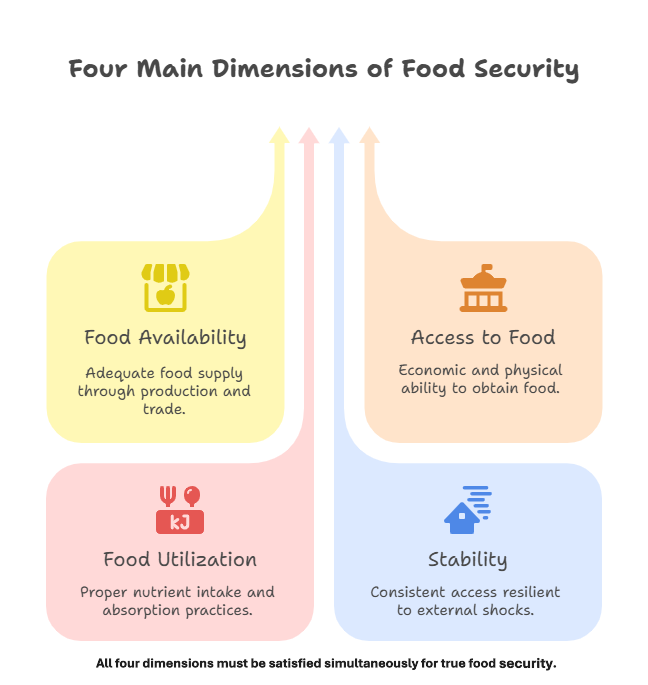Facts for UPSC Mains
India at the Forefront of Global Food Security
- 27 Aug 2025
- 8 min read
Why in News?
India and the World Food Programme (WFP) signed a Letter of Intent for India to supply fortified rice to vulnerable populations worldwide, using its agricultural surplus to support global food security.
How does India Shape the Global Food Security Landscape?
- Major Global Producer and Exporter: India is a food surplus country today, standing as the largest producer of milk, pulses, and spices, and the second largest producer of food grains, fruits, vegetables, cotton, sugar, tea, and farmed fish.
- India exports a wide range of products, including milk, pulses, horticulture, shrimp, and spices, supporting global nutrition and generating economic gains.
- Research & Innovation: Indian institutions like Indian Council of Agricultural Research (ICAR) share agri-tech, high-yield seeds, and sustainable farming practices with Africa and Asia under South-South Cooperation.
- India as an Architect of Food Security Solutions: Programs like the National Food Security Act (2013), POSHAN Abhiyaan and Pradhan Mantri Garib Kalyan Anna Yojana strengthen domestic food security and nutrition, offering replicable solutions for other developing nations.
- Humanitarian Assistance: India provides emergency food aid to countries in crisis, such as Afghanistan, African nations, as seen during the Covid-19 pandemic, using mechanisms like the WFP for distribution.
- World Trade Organization (WTO) Negotiations: India champions the cause of developing nations’ right to public stockholding, protecting food security of billions.
- Promotion of Climate-Smart Practices: India promotes millets (International Year of Millets 2023) as climate-resilient crops, offering sustainable solutions to global hunger.
Food Security Scenario in India
- The National Food Security Act (NFSA) 2013 shifted India’s food security from welfare to a rights-based approach, covering up to 75% of rural and 50% of urban populations.
- Currently, about 80 crore people receive highly subsidized foodgrains.
- Measures like digitizing ration cards and the One Nation, One Ration Card scheme(ONORC) improved transparency, allowing beneficiaries to access entitlements nationwide.
- There was also a growing focus on nutritional security through programs like POSHAN Abhiyaan and bio-fortified crops to address malnutrition and "hidden hunger" by diversifying the Public Distribution System basket.
- Additionally, the government promoted sustainable farming practices through schemes like Paramparagat Krishi Vikas Yojana (organic farming) and the National Mission for Sustainable Agriculture to ensure long-term food security.
What are India’s Key Food Security Challenges and How can they be Tackled?
|
Challenge |
Measures to Tackle It |
|
Decreasing Per capita Food Availability: 510.1 grams per day per person in 1991 to 507.9 grams in 2021.
|
Improve storage and transportation infrastructure to reduce food waste. Invest in cold chain systems to prevent loss of perishable goods like fruits and dairy. |
|
Rising Vulnerability to Climate Change: Rising temperatures, erratic rainfall, and extreme weather reduce crop yields and disrupt supply chains. |
Speeding up the implementation of the National Innovations in Climate Resilient Agriculture (NICRA) Scheme in vulnerable villages. Promote crop diversification and expand drip irrigation to enhance resilience, soil fertility, and yield stability. |
|
Nutritional Challenge: 35.5% of children under age five years are stunted. 67% of children and 57% of women affected by anemia.
|
Fortify foods with essential micronutrients like iron and vitamin B12. Implement iron supplementation programs for women and children. |
|
Public Distribution System (PDS) Issues: 28% of allocated grains failing to reach beneficiaries due to leakage.
|
Implement blockchain and IoT for digital tracking from procurement to distribution. Transform fair price shops into smart shops with biometric and QR code-based quality checks. Strengthen One Nation One Ration Card Plan with centralized databases and migration tracking for seasonal migrants. |
What is the World Food Programme (WFP)?
- Establishment: The World Food Programme (WFP) is a United Nations agency focused on hunger eradication and food security, established in 1961 by the UN General Assembly and Food and Agriculture(FAO).
- Headquarters: Rome, Italy.
- Approach: Invests in local nutritious food solutions, fortification, and social protection systems.
- Empowers vulnerable communities to withstand shocks via improved livelihoods and climate resilience.
- Builds institutional capacity at the local level and addresses gender inequalities affecting food security.
- Recognition: WFP was awarded the Nobel Peace Prize in 2020.
- India and WFP Collaboration: India, upholding the principle of Vasudhaiva Kutumbakam (the world as one family), is collaborating with WFP through initiatives like Supply Chain Optimization, Fortified Rice Rollout, Grain ATMs (Annapurti Devices), Jan Poshan Kendra, Smart Warehousing, and Mobile Storage Units (Flospans), while exploring further avenues for partnership.
Conclusion
India’s efforts to enhance food security contribute directly to SDG 2: Zero Hunger, SDG 12: Responsible Consumption and Production. Through initiatives like fortified rice, climate-resilient agriculture, and improved nutrition programs, India supports both national and global food security.
Related Keywords for Mains
- “Nutrition Without Borders”: Delivering fortified food to the most vulnerable worldwide.
- “From Entitlement to Empowerment” : Self-reliant food systems.
- “Food Aid is Soft Aid” : Diplomacy through wheat, rice, pulses.
- “Leakages to Linkages”: PDS reforms through JAM trinity.
|
Drishti Mains Question: Q. Discuss the four dimensions of food security and assess India’s shift from a food-deficit to a food-surplus nation, highlighting its role in global food security. |
UPSC Civil Services Examination, Previous Year Question (PYQ)
Mains
Q. Food Security Bill is expected to eliminate hunger and malnutrition in India. Critically discuss various apprehensions in its effective implementation along with the concerns it has generated in WTO. (2013)







